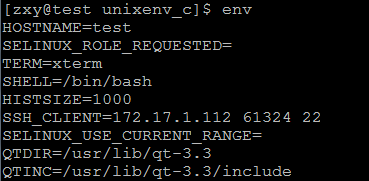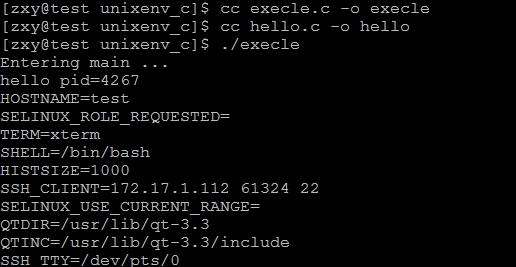本节目标:
- exec替换进程映像
- exec关联函数组(execl、execlp、execle、execv、execvp)
一,exec替换进程映像
在进程的创建上Unix采用了一个独特的方法,它将进程创建与加载一个新进程映象分离。这样的好处是有更多的余地对两种操作进行管理。
当我们创建了一个进程之后,通常将子进程替换成新的进程映象,这可以用exec系列的函数来进行。当然,exec系列的函数也可以将当前进程替换掉。
例如:在shell命令行执行ps命令,实际上是shell进程调用fork复制一个新的子进程,在利用exec系统调用将新产生的子进程完全替换成ps进程。
二,exec系列函数(execl、execlp、execle、execv、execvp)
包含头文件<unistd.h>
功能:
用exec函数可以把当前进程替换为一个新进程,且新进程与原进程有相同的PID。exec名下是由多个关联函数组成的一个完整系列,
头文件<unistd.h>
extern char **environ;
原型:
int execl(const char *path, const char *arg, ...);
int execlp(const char *file, const char *arg, ...);
int execle(const char *path, const char *arg, ..., char * const envp[]);
int execv(const char *path, char *const argv[]);
int execvp(const char *file, char *const argv[]);
参数:
path参数表示你要启动程序的名称包括路径名
arg参数表示启动程序所带的参数,一般第一个参数为要执行命令名,不是带路径且arg必须以NULL结束
返回值:成功返回0,失败返回-1
注:上述exec系列函数底层都是通过execve系统调用实现:
#include <unistd.h>
int execve(const char *filename, char *const argv[],char *const envp[]);
DESCRIPTION:
execve() executes the program pointed to by filename. filename must be
either a binary executable, or a script starting with a line of the form
以上exec系列函数区别:
1,带l 的exec函数:execl,execlp,execle,表示后边的参数以可变参数的形式给出且都以一个空指针结束。
示例:
#include <stdio.h> #include <stdlib.h> #include <unistd.h> int main(void) { printf("entering main process--- "); execl("/bin/ls","ls","-l",NULL); printf("exiting main process ---- "); return 0; }
利用execl将当前进程main替换掉,所有最后那条打印语句不会输出
2,带 p 的exec函数:execlp,execvp,表示第一个参数path不用输入完整路径,只有给出命令名即可,它会在环境变量PATH当中查找命令
示例:
当不带p但没给出完整路径时:
#include <stdio.h> #include <stdlib.h> #include <unistd.h> int main(void) { printf("entering main process--- "); execl("/bin/ls","ls","-l",NULL); printf("exiting main process ---- "); return 0; }
结果:
结果显示找不到,所有替换不成功,main进程继续执行
现在带p:
替换成功
3,不带 l 的exec函数:execv,execvp表示命令所需的参数以char *arg[]形式给出且arg最后一个元素必须
是NULL
示例:
#include <stdio.h> #include <stdlib.h> #include <unistd.h> int main(void) { printf("entering main process--- "); int ret; char *argv[] = {"ls","-l",NULL}; ret = execvp("ls",argv); if(ret == -1) perror("execl error"); printf("exiting main process ---- "); return 0; }
结果:
进程替换成功
4,带 e 的exec函数:execle表示,将环境变量传递给需要替换的进程
从上述的函数原型中我们发现:
extern char **environ;
此处的environ是一个指针数组,它当中的每一个指针指向的char为“XXX=XXX”
environ保存环境信息的数据可以env命令查看:
它由shell进程传递给当前进程,再由当前进程传递给替换的新进程
示例:execle.c
#include <stdio.h> #include <stdlib.h> #include <unistd.h> int main(int argc, char *argv[]) { //char * const envp[] = {"AA=11", "BB=22", NULL}; printf("Entering main ... "); int ret; ret =execl("./hello", "hello", NULL); //execle("./hello", "hello", NULL, envp); if(ret == -1) perror("execl error"); printf("Exiting main ... "); return 0; }
hello.c
#include <unistd.h> #include <stdio.h> extern char** environ; int main(void) { printf("hello pid=%d ", getpid()); int i; for (i=0; environ[i]!=NULL; ++i) { printf("%s ", environ[i]); } return 0; }
结果:
可知原进程确实将环境变量信息传递给了新进程
那么现在我们可以利用execle函数自己给的需要传递的环境变量信息:
示例程序:execle.c
#include <stdio.h> #include <stdlib.h> #include <unistd.h> int main(int argc, char *argv[]) { char * const envp[] = {"AA=11", "BB=22", NULL}; printf("Entering main ... "); int ret; //ret =execl("./hello", "hello", NULL); ret =execle("./hello", "hello", NULL, envp); if(ret == -1) perror("execl error"); printf("Exiting main ... "); return 0; }
hello.c
#include <unistd.h> #include <stdio.h> extern char** environ; int main(void) { printf("hello pid=%d ", getpid()); int i; for (i=0; environ[i]!=NULL; ++i) { printf("%s ", environ[i]); } return 0; }
结果:
确实将给定的环境变量传递过来了
三,fcntl()函数中的FD_CLOEXEC标识在exec系列函数中的作用
#include <unistd.h>
#include <fcntl.h>
int fcntl(int fd, int cmd, ... /* arg */ );
File descriptor flags
The following commands manipulate the flags associated with a file
descriptor. Currently, only one such flag is defined: FD_CLOEXEC, the
close-on-exec flag. If the FD_CLOEXEC bit is 0, the file descriptor
will remain open across an execve(2), otherwise it will be closed.
//如果FD_CLOEXEC标识位为0,则通过execve调用后fd依然是打开的,否则为关闭的
F_GETFD (void)
Read the file descriptor flags; arg is ignored.
F_SETFD (long)
Set the file descriptor flags to the value specified by arg.
如:fcntl(fd, F_SETFD, FD_CLOEXEC);
测试示例:
#include <stdio.h> #include <stdlib.h> #include <unistd.h> #include <fcntl.h> int main(int argc, char *argv[]) { printf("Entering main ... "); int ret = fcntl(1, F_SETFD, FD_CLOEXEC); if (ret == -1) perror("fcntl error"); int val; val =execlp("ls", "ls","-l", NULL); if(val == -1) perror("execl error"); printf("Exiting main ... "); return 0; }
结果:
1关闭(标准输出关闭)ls -l无法将结果显示在标准输出







